The best homemade cacio e pepe
One of the things I miss most about living in Rome (apart from the awesome friends we had to leave behind) is not having steady access to decent cacio e pepe. I’ve written before about my love for this dish, how it completely changed the way I think about food. And it’s the first thing I order whenever I’m in Italy.
To make things worse, I’ve never been able to successfully recreate the dish at home. The versions I make are always too gloopy, or it’s too wet, or it’s too flavourless.
Until Kenji.
In my house, Kenji Lopez-Alt is to food what Mark Kermode is to films. Nothing gets made without first asking “how would Kenji make this?” and consulting his book, The Food Lab (which might be my favourite cookbook). So, on a whim, I checked out what he had to say about homemade cacio e pepe. And he’s got a video about it. I made his version tonight and it was, without a doubt, the best cacio e pepe I’ve ever made.
A couple of notes about his recipe:
- Don’t use fresh pasta for this. The timings are for dry pasta and they’re relatively precise - if you use fresh pasta, your pasta will be done before the oil has had time to cool down, so your butter won’t emulsify with it. Plus, this is just a personal thing, but I think fresh pasta is kinda wanky anyway. If you’re trying to impress someone with this dish, you’re much better of spending your money on better quality cheese.
- Maybe use normal olive oil to fry the pepper at the start. Even being as gentle as possible, the extra virgin just has a sharpness to it that can overpower the cheese. Drizzling extra virgin at the end is plenty.
Films I Watched in 2016
For the last few years, I’ve been using Letterboxd to keep a track of every film I watch. According to my Letterboxd profile, I watched a total of 92 films in 2016. Which is the same number of films as I watched in 2015, which isn’t bad, considering my wife and I had a child in early January, which severely limited our trips to the cinema.
I also scored each film I watched, with a maximum score of five. Which lets me pull out some statistics1!
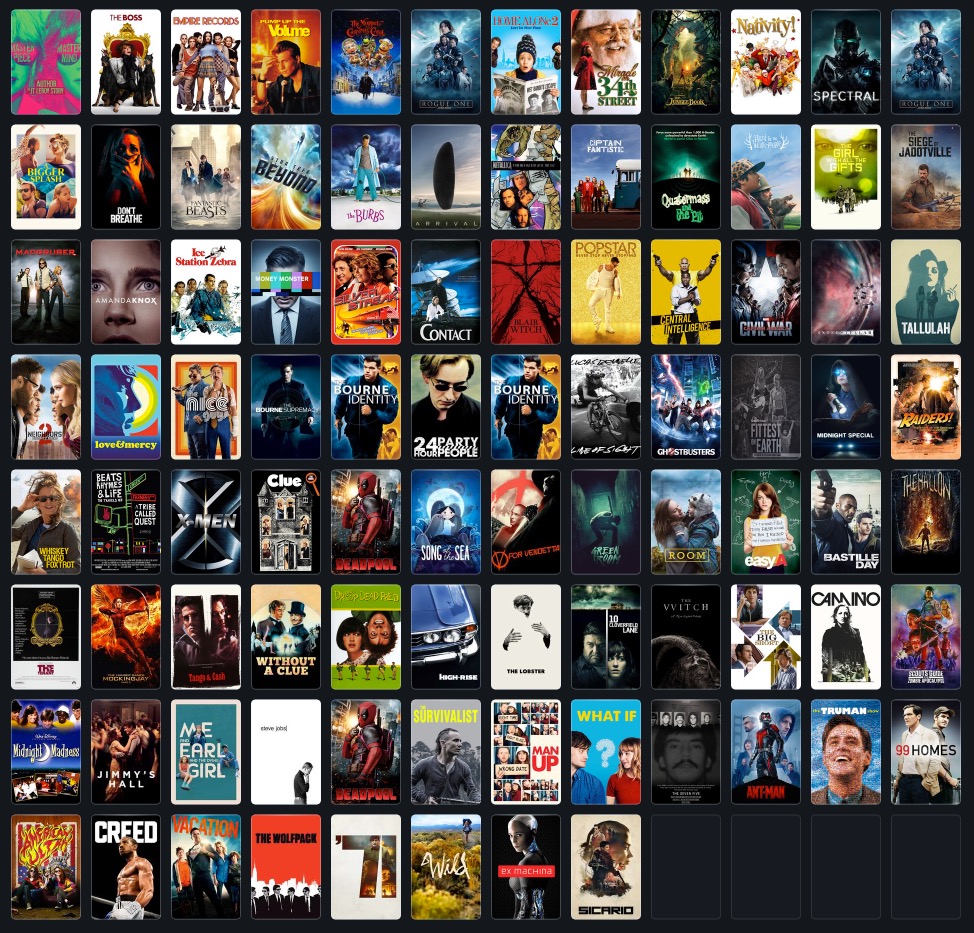
The average score across all films was 3.1 / 5, which is pretty good2! The lowest score I gave a film was 1 / 5 (actually, I gave it to two films: Camino and Scouts Guide to the Zombie Apocalypse). The highest score this year was 4.5 / 5. The films I rated the highest this year were Rogue One (which I saw twice), Hunt for the Wilderpeople, Green Room and Steve Jobs.
92 films averages to 1.8 films a week. The graph of when these films were watched tells a bit of a story of the year. First week of the year, when my wife was heavily pregnant and ready to pop, we watched five films. Then, the entire month of April, when my baby was waking four or five times a night? One film.
I only reviewed 43 of the 92 films I watched in 2016, which is a shame, because my little reviews are more helpful to me in remembering why I gave a film a particular score. I could barely remember watching Scouts Guide to the Zombie Apocalypse, but my review – my little note to amuse no-one but myself – reminded me why I gave it 1 / 5.
-
For context on the scoring, I have given nine films a perfect score of 5/5. ↩︎
-
Last year, the average score was 2.8 / 5, so either films are getting better or I’m doing a better job of avoiding bad ones, I guess? ↩︎
Best Games I Played in 2016
Every year, I do a roundup of my favourite games that I played throughout the year. Previous years: 2013, 2014, 2015
Everybody’s Gone to the Rapture
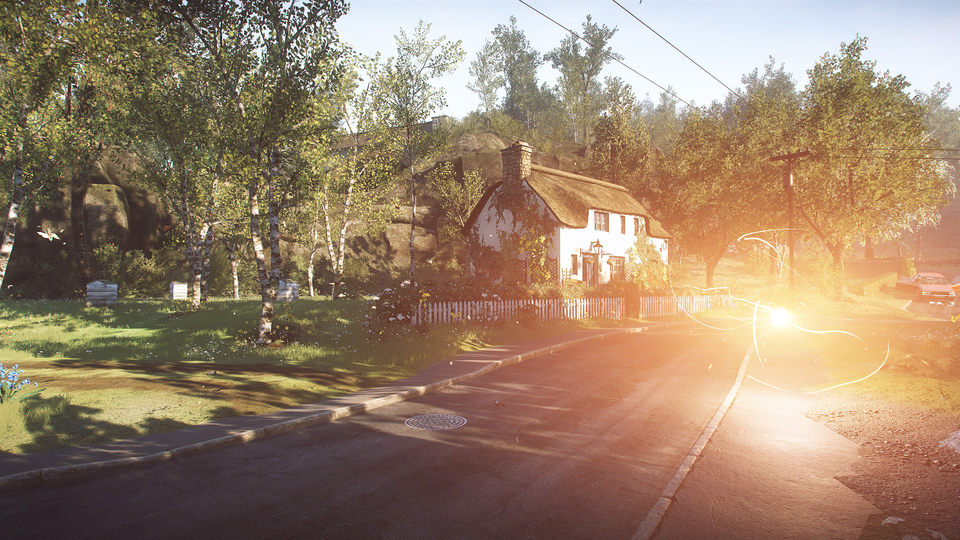 Okay, so technically this game came out in 2015, which is a great start to a year-end list for 2016. I played it when it first came out and it just didn’t click with me. I’m not sure why. I knew going in that it fell under the ‘walking simulator’ umbrella. But I guess I was expecting more of a Gone Home style experience, where the game gives you an environment to explore and examine and a story that you uncover — or flesh out — for yourself. Except, as I found out, EGTTR is not that type of game. It’s more like a radio play crossed with a heavy dose of Sleep No More. So, last month, I went back and played it like that, like it was a play that I was witnessing rather than actually being any part of, and the game bowled me over. It’s poetic and beautiful without ever being mawkish and it’s one of a handful of games to have ever made me cry.
Okay, so technically this game came out in 2015, which is a great start to a year-end list for 2016. I played it when it first came out and it just didn’t click with me. I’m not sure why. I knew going in that it fell under the ‘walking simulator’ umbrella. But I guess I was expecting more of a Gone Home style experience, where the game gives you an environment to explore and examine and a story that you uncover — or flesh out — for yourself. Except, as I found out, EGTTR is not that type of game. It’s more like a radio play crossed with a heavy dose of Sleep No More. So, last month, I went back and played it like that, like it was a play that I was witnessing rather than actually being any part of, and the game bowled me over. It’s poetic and beautiful without ever being mawkish and it’s one of a handful of games to have ever made me cry.
Rise of the Tomb Raider/Uncharted 4
 I don’t think it’s cheating to put both of these games on here. They’re both really fun games that are great at different things. Uncharted had a great, grown-up story (a hero trying to settle down and re-adjust his priorities) and had the best free-flowing combat of any game I’ve played this year. In the previous Uncharted games, I’d hide behind cover and pick off the baddies one-by-one. In this, I was finally whizzing around the levels like the badass the game wanted me to be. Tomb Raider, on the other hand, had better, uh, tombs. Better puzzles that took advantage of the environment. The Baba Yaga DLC (which comes loaded on the PS4 disk) is stunning and a wild departure from what you’d expect from a triple-A blockbuster game.
I don’t think it’s cheating to put both of these games on here. They’re both really fun games that are great at different things. Uncharted had a great, grown-up story (a hero trying to settle down and re-adjust his priorities) and had the best free-flowing combat of any game I’ve played this year. In the previous Uncharted games, I’d hide behind cover and pick off the baddies one-by-one. In this, I was finally whizzing around the levels like the badass the game wanted me to be. Tomb Raider, on the other hand, had better, uh, tombs. Better puzzles that took advantage of the environment. The Baba Yaga DLC (which comes loaded on the PS4 disk) is stunning and a wild departure from what you’d expect from a triple-A blockbuster game.
TIS-100/Quadrilateral Cowboy
 Look, if I can put Uncharted and Tomb Raider together on this list because of a thematic link, I can definitely put TIS-100 and Quadrilateral Cowboy together. In TIS-100, you have to solve a series of programming puzzles by writing assembly. Assembly! It’s frustrating and you spend most of your play-time just staring at the screen, not typing anything. And oh my God, it’s so rewarding when you finally figure it out. Just like real programming! Best part is that when you solve it, it shows you a leaderboard of how you did compared to your steam friends. If you’ve got nerdy programming friends, this is a huge pissing contest and it’s great.
Look, if I can put Uncharted and Tomb Raider together on this list because of a thematic link, I can definitely put TIS-100 and Quadrilateral Cowboy together. In TIS-100, you have to solve a series of programming puzzles by writing assembly. Assembly! It’s frustrating and you spend most of your play-time just staring at the screen, not typing anything. And oh my God, it’s so rewarding when you finally figure it out. Just like real programming! Best part is that when you solve it, it shows you a leaderboard of how you did compared to your steam friends. If you’ve got nerdy programming friends, this is a huge pissing contest and it’s great.
On the other hand, Quadrilateral Cowboy is about hacking to pull off elaborate heists. William Gibson meets Oceans Eleven. The game’s action is more physical than TIS-100. You type your commands into your ‘deck’ in the game. For example, you program a door to open for five seconds, which should be just enough time for you to grab your deck and run through before the door shuts but not so long that the alarm will trigger. The real fun comes in stringing together a series of commands so that things will happen in sequence and allow you to steal the maguffin. Get that timing just right and you felt like you’re in Mission Impossible or something. But like, one of the good ones.
The Witness
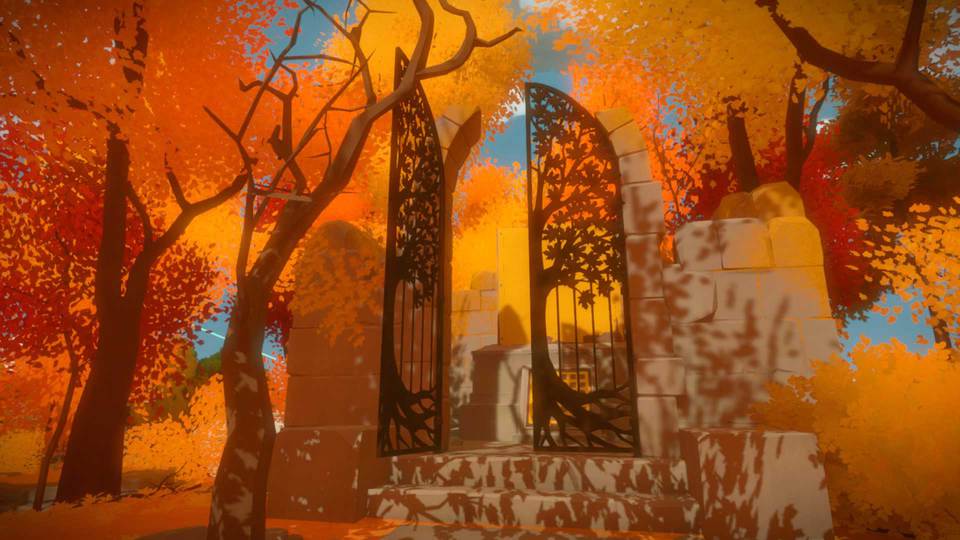 Stop me if you’ve heard me tell this story before. When I was in my early twenties, I taught myself how to juggle. And the hardest part, I found, was just getting my brain to learn to let go of that third ball when two were already in flight. I spent weeks trying to throw that third ball in the air. I just couldn’t do it. My hand wouldn’t release it. Then, one day, something clicked – and I mean clicked, like I felt a physical sensation in my brain – and I could suddenly do it, no problem.
Stop me if you’ve heard me tell this story before. When I was in my early twenties, I taught myself how to juggle. And the hardest part, I found, was just getting my brain to learn to let go of that third ball when two were already in flight. I spent weeks trying to throw that third ball in the air. I just couldn’t do it. My hand wouldn’t release it. Then, one day, something clicked – and I mean clicked, like I felt a physical sensation in my brain – and I could suddenly do it, no problem.
The Witness was that feeling again and again and again. Puzzles you think you’ll never be able to do, then suddenly, something clicks and you’re able to solve them. And then you build on that knowledge when you encounter the next thing you think you’ll never be able to do. Rewarding and beautiful.
Firewatch
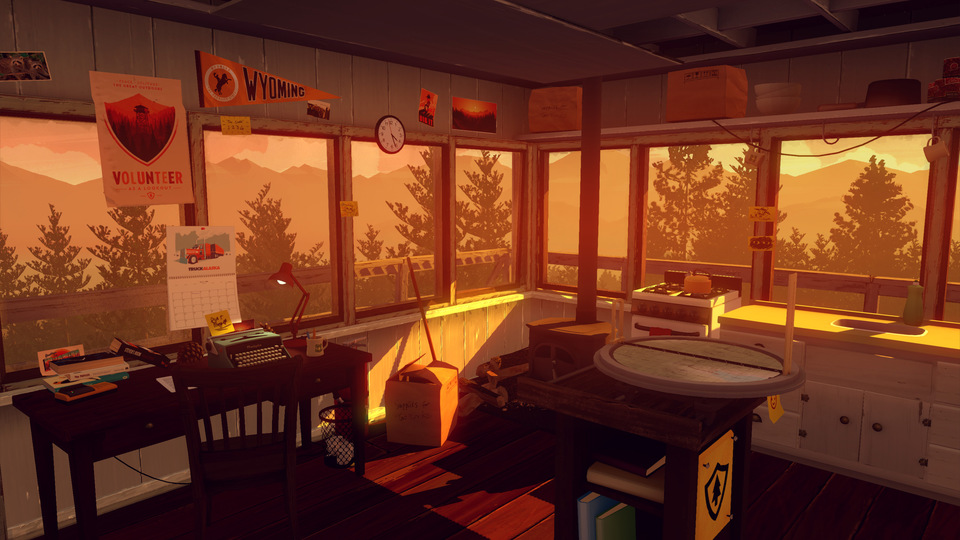 Firewatch starts with a strong emotional flourish every bit as powerful as the opening of Pixar’s Up. And the genius of this bit of storytelling is that it completely affects the way you play the game, the choices you make. It’s a walking simulator – a nice hike in the woods simulator, really – with a deep undercurrent of melancholy and loss. The development team has a pedigree that meant I was at least expecting something interesting. I wasn’t expecting something so mature, so confident and so emotionally resonant.
Firewatch starts with a strong emotional flourish every bit as powerful as the opening of Pixar’s Up. And the genius of this bit of storytelling is that it completely affects the way you play the game, the choices you make. It’s a walking simulator – a nice hike in the woods simulator, really – with a deep undercurrent of melancholy and loss. The development team has a pedigree that meant I was at least expecting something interesting. I wasn’t expecting something so mature, so confident and so emotionally resonant.
Hitman
 This year’s Hitman got so many things right. The slow roll-out of episodes meant that you didn’t feel that compulsion to just finish one level as quickly as possible so you could move onto the next one. You had time to get comfortable with each level and slowly ease yourself into the game’s mechanics. It also meant you were encouraged to explore, to try different things, try absurd things. But the thing I loved most about it was how ridiculous it allowed itself to be. It embraces the silliness of the game, from the opening training level set on a soundstage with a cardboard helicopter, right through to the Christmas DLC where your targets are the burglars from Home Alone. This was the first Hitman game I truly enjoyed.
This year’s Hitman got so many things right. The slow roll-out of episodes meant that you didn’t feel that compulsion to just finish one level as quickly as possible so you could move onto the next one. You had time to get comfortable with each level and slowly ease yourself into the game’s mechanics. It also meant you were encouraged to explore, to try different things, try absurd things. But the thing I loved most about it was how ridiculous it allowed itself to be. It embraces the silliness of the game, from the opening training level set on a soundstage with a cardboard helicopter, right through to the Christmas DLC where your targets are the burglars from Home Alone. This was the first Hitman game I truly enjoyed.
Anatomy
 There were a lot of quote-unquote ‘horror’ games in 2016 (I feel like the world reached peak ‘survival’ game this year), but these were mostly of the quiet-quiet-LOUD jump-scare variety. That’s fun and all, but it’s so one-note, it gets a little repetitive. Only one game genuinely chilled me this year and it was Kitty Horrorshow’s Anatomy. A short, brutally efficient horror experience, which gives you the most mundane environment – a suburban home – then changes that out from underneath you on subsequent playthroughs. This is the simplest game on this list but it’s the one that’s stuck with me the most.
There were a lot of quote-unquote ‘horror’ games in 2016 (I feel like the world reached peak ‘survival’ game this year), but these were mostly of the quiet-quiet-LOUD jump-scare variety. That’s fun and all, but it’s so one-note, it gets a little repetitive. Only one game genuinely chilled me this year and it was Kitty Horrorshow’s Anatomy. A short, brutally efficient horror experience, which gives you the most mundane environment – a suburban home – then changes that out from underneath you on subsequent playthroughs. This is the simplest game on this list but it’s the one that’s stuck with me the most.
Overwatch
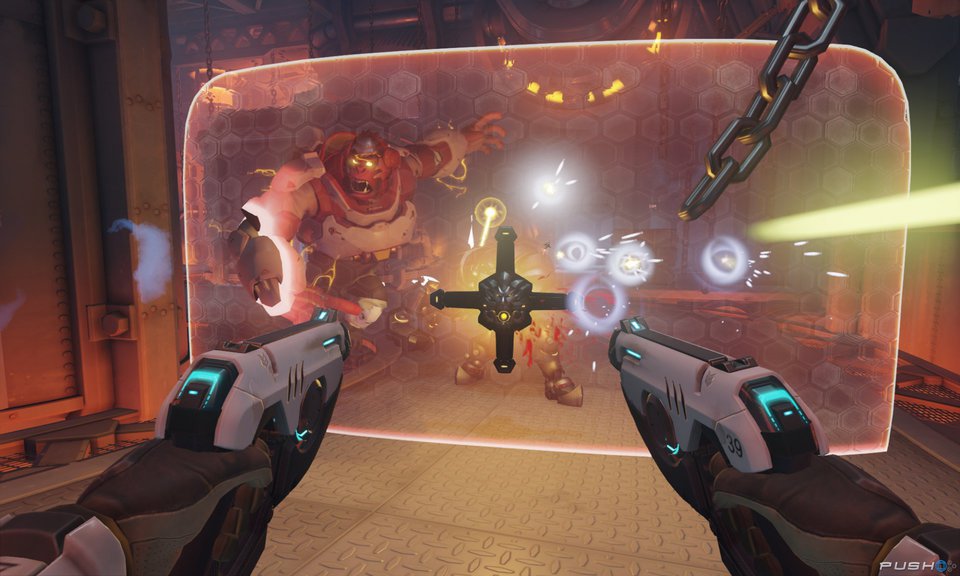 I’m terrible at shooting games. Just terrible. I’ve got old man hands, slow reactions and poor situational awareness. Oh, and I panic really easily. But here’s what I loved about Overwatch: none of this matters. You can have all of these things and still contribute to you team’s success.
I’m terrible at shooting games. Just terrible. I’ve got old man hands, slow reactions and poor situational awareness. Oh, and I panic really easily. But here’s what I loved about Overwatch: none of this matters. You can have all of these things and still contribute to you team’s success.
Inside
 Stylistically, this is kind of reminiscent of the developer’s previous game, Limbo. But while Limbo was a cold, austere game with beautiful visuals, there’s something warm and human1 about Inside. A few minutes into the game, you’re followed by a gang of chicks. It’s one of the cutest things you’ll see. Tiny chirping pixels following you around. A little while later, a puzzle involves you sucking these chicks into a machine so they get spat out the top to hit a block and knock it where you can use the block. Then the chicks all run off. Except one. A chick — a tiny group of pixels — doesn’t move. And it’s devastating.
Stylistically, this is kind of reminiscent of the developer’s previous game, Limbo. But while Limbo was a cold, austere game with beautiful visuals, there’s something warm and human1 about Inside. A few minutes into the game, you’re followed by a gang of chicks. It’s one of the cutest things you’ll see. Tiny chirping pixels following you around. A little while later, a puzzle involves you sucking these chicks into a machine so they get spat out the top to hit a block and knock it where you can use the block. Then the chicks all run off. Except one. A chick — a tiny group of pixels — doesn’t move. And it’s devastating.
Possibly the most heartbreaking thing in a game in 2016 #PS4share pic.twitter.com/lUjT0BTqYC
— John Kelly (@johnke) 18 September 2016
The Last Guardian
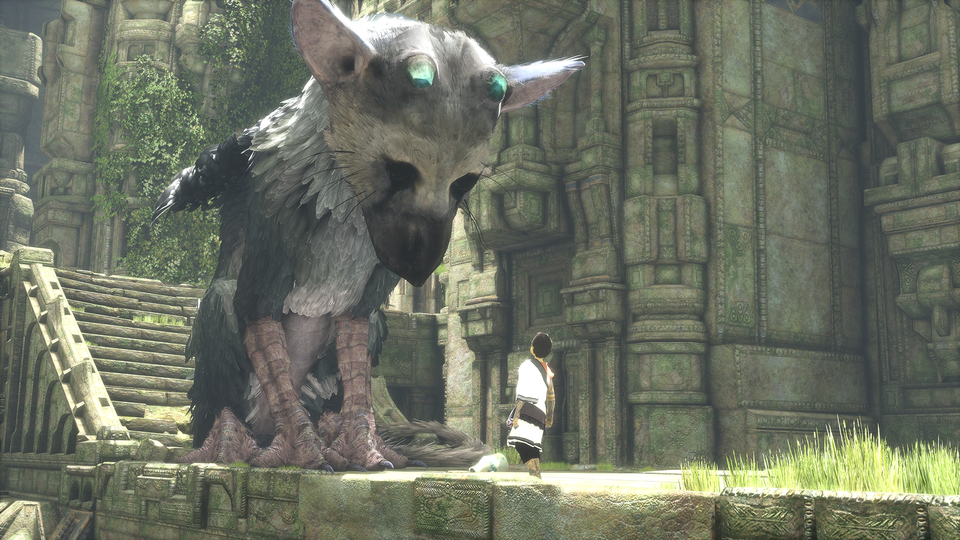 For the first couple of hours with The Last Guardian, I was worried. I was finally playing the game I’d been waiting almost nine years for. The game whose original announcement had me rushing out to buy a PS3 the next day. The game that was the spiritual sequel to two of my favourite games of all time. And I wasn’t enjoying it. It was cold and clunky. Was this what I’d been waiting for? But then I got to the part they’d shown in countless trailers. Jumping from bridge to bridge. And when Trico reached out to catch me with his mouth but missed and then swung his tail around for me to catch, I found myself holding my breath. Even though I’d seen this happen before. And I knew the game had worked its magic and got its hooks in me, hard.
For the first couple of hours with The Last Guardian, I was worried. I was finally playing the game I’d been waiting almost nine years for. The game whose original announcement had me rushing out to buy a PS3 the next day. The game that was the spiritual sequel to two of my favourite games of all time. And I wasn’t enjoying it. It was cold and clunky. Was this what I’d been waiting for? But then I got to the part they’d shown in countless trailers. Jumping from bridge to bridge. And when Trico reached out to catch me with his mouth but missed and then swung his tail around for me to catch, I found myself holding my breath. Even though I’d seen this happen before. And I knew the game had worked its magic and got its hooks in me, hard.
-
And sub-human - that little mermaid girl still gives me nightmares ↩︎
A Platform for Trolls (continued)
I’ve been thinking a little more on the problem of [giving a platform to trolls][1].
On the same day that Donald “I don’t settle” Trump settled his Trump university lawsuit, he also tweeted his disapproval at the way Mike Pence was addressed by the cast of Hamilton. One of these was an enormous story with long-ranging implications, the other was someone being pissy about hurt feelings. Which of these was the main news story on lots of newspapers (including hte New York Times)? The tweet, obviously.
During the summer, Twitter took the extraordinary step of issuing a lifetime ban on “@nero" – Milo Yiannopolis – for directing hate speech. This almost instantly decimated the “gamer gate” movement on Twitter1. It was like someone opened the windows and let in some air. Twitter briefly became a slightly nicer place.
Now, imagine twitter banned Donald Trump. I don’t know why, but you could easily argue “hate speech” too. Imagine the effect that would have on the news cycle. Non-issues would be avoided. “Rich white man has hurt feelings” wouldn’t generate pages and pages of think-pieces. [We could focus on issues instead of imaginary ‘scandals’][2]. Imagine how much less toxic the world would be.
Sure, Twitter’s investors would have a goddamn heart attack and never let it happen, but still, it’s nice to imagine, isn’t it?
-
It’s not entirely dead, but without anyone actually driving or directing the clown car, its effect has been dramatically reduced. [1]: http://lowbrowculture.com/post/platform-for-trolls/ [2]: https://www.engadget.com/2016/10/20/climate-change-took-a-backseat-to-scandal-at-the-presidential-de/ ↩︎
Choice and achievements
I’ll make a bet with you: you give me a game that presents the player with a quote-unquote “moral choice” – who you fuck/marry/kill – and I’ll bet you cash money that there’s a trophy or an achievement for at least one of your choices.
Games like Mass Effect (the classic whipping boy for “choice” in games) have a black and white sense of morality. You’re either a saint to everyone you meet or you’re a complete asshole. These games have achievements for playing exclusively in one way or the other, which just encourages the player to min-max their moral compass and not necessarily make the decisions they actually want to.
This is what I loved about the recent Rise of the Tomb Raider. The bad guy is a total dick to your character throughout the game, so when you finally beat him (spoiler alert: you beat the baddie at the end of the game), you’re given the choice to either walk away and leave him to die or walk up to him and straight-up merc that prick.
By the time I reached this part of the game and I had to decide what to do, I followed my typical first instinct in these situations. I paused the game, then went online to find out if there was a hidden trophy for either decision, because if so, that’s the choice I’d make. Games had conditioned me to expect my choice to be rewarded, one way or the other. “Ding! You took the moral high ground, here’s a trophy!”
With the final bad guy in Rise of the Tomb Raider, there’s no trophy. No extrinsic reward telling you that you did a good job. So, unusually for a game in 2016, you’re free to do whatever feels right for you.
And that’s so refreshing.
# Nov 21, 2016A Platform for Trolls
Last Friday, Ireland’s national broadcaster, RTÉ, invited professional troll Katy Hopkins to be a guest on its flagship light entertainment show, The Late Late Show.
Although it’s subsidised by license fees, RTÉ gets almost half its funding from advertising. Meaning its revenue is directly affected by the number of viewers it gets.
And this is how we end up with people like Katy Hopkins on the Late Late Show. Someone that no-one wanted to see, no-one wanted to listen to, someone whose appearance drew an enormous 1,300 complaints. She ends up on their prime time chat show because it got people talking.
Reasonable opinions don’t go viral. People don’t tweet en masse when a guest on a TV show says something sensible.
Sensible people — people who care about things like acceptance and inclusion — were complaining about Katy Hopkins being on the show. They talked about how they weren’t going to watch the show, and everyone inside the same echo chamber of opinions repeated the same thing, over and over again.
Meanwhile, the people who were insulated from the uproar, the people who don’t know who Katy is (or worse, the people that agree with her) just watched the show anyway. Along with, I’ll bet, a lot of the people who said they wouldn’t. And then come the complaints to RTÉ and the cycle continues.
On a similar note, Mark Zuckerberg released a statement last week denying that fake news stories on Facebook had any impact on the US election. A site that relies on advertising revenue saying that content on that site can’t influence people? Bullshit, right?
Well, if the group in Facebook working to fight back against these fake news stories, it’s totally bullshit. Quoting one anonymous Facebooker “to highlight fake news articles in the news feed, to promote them so they get millions of shares by people who think they are real, that’s not something we should allow to happen. Facebook is getting played by people using us to spread their bullshit.”
In chasing controversy — for views, clicks or whatever — media outlets like RTÉ, Facebook and Twitter are directly responsible for a lowering of the standard of general discourse. They’re normalising hatred and intolerance. They give a platform to trolls because it’s profitable for them, and they ignore the wider social impact. And I don’t think that’s good enough any more.
I don’t really a solution for any of this. I’ve just been feeling really demoralized for the last week and wanted to get this off my chest. So, in lieu of a conclusion, here’s a photo of Christoph Waltz eating a hamburger to cheer us all up.

Update 20161130: Gizmodo recently ran an article about Reddit tearing itself apart. tl;dr the /r/The_Donald subreddit is driving lots of pro-Trump engagement (in all its hate-spreading glory) while driving other traffic away and alienating moderators.
# Nov 15, 2016What's Making me Happy - Week of August 22nd
These Mysterious Symbols Have Been in 19 Video Games and No One Knows Why
A strange sigil has been cropping up in (mostly indie) games and, thanks to some amazing detective work on the part of some redditors, it appears to be pointing to some kind of ARG. Is this Frog Fractions 2? Is lowbrowculture.com Frog Fractions 2? If you want to get deeper down the rabbit hole of this, I can recommend the /r/gamedetectives subreddit which consumed a lot of my productivity last week, especially their work on Overwatch’s apparent “Sombra ARG”, where it’s perfectly reasonable to take a random line of source code from a web page, run it through a Vigenére cipher (using the passphrase gained from a previous bit of detective work) and then diff’ing the resulting “datamoshed” image with an original image to get even more clues. I love this stuff. (Incidentally, this is the second week in a row an article from Patrick Klepek has been making me happy. He’s doing amazing work at Vice.)
Fake human sacrifice filmed at Cern, with pranking scientists suspected
Let’s just take a look at the lede to this story:
Spokeswoman at high temple of particle physics suggests ‘scientific users’ of the Geneva facility ‘let their humour go too far’ with staging of occult rite
Holy shit. Something about the phrase “pranking scientists suspected” doesn’t fill me with confidence.
Disney’s Practical Guide to Path Tracing
Walt Disney Animation studios have put up a primer on a super-technical high-tech subject presented as if it was a 1950s documentary. It’s really informative and really charming. See also Disney’s Practical Guide to Snow Simulation.
How much faster would it be to render Toy Story in 2011 compared to how long it took in 1995?
Speaking of Pixar, Quora has some real gems hidden away deep in its belly. Like this fascinating 2011 answer from Craig Good, Pixar boffin, about the render times for the original cinema release of Toy Story vs the 2010 remaster.
All Mapped Out
Popbitch goes deep into the Yeah Yeah Yeah’s Maps, digging into the music theory behind what makes it so unique and why it turns up under so many pop songs. Why did the Black Eyed Peas sample the intro? Let’s take a look at the drum tab to find out, shall we?
# Aug 22, 2016What's Making me Happy - Week of August 15th
Spaceplan (game)

I’ve got a real soft spot for ‘clicker’ games. Things like Cookie Clicker and Candy Box just hoover up my productivity (honestly, I went to look up the URLs for these and I just lost 20 minutes to Cookie Clicker again). Spaceplan does nothing new with the formula, but it’s very slickly done and, unlike most other games of the genre, this one actually has a well-written story.
No Man’s Sky (game)
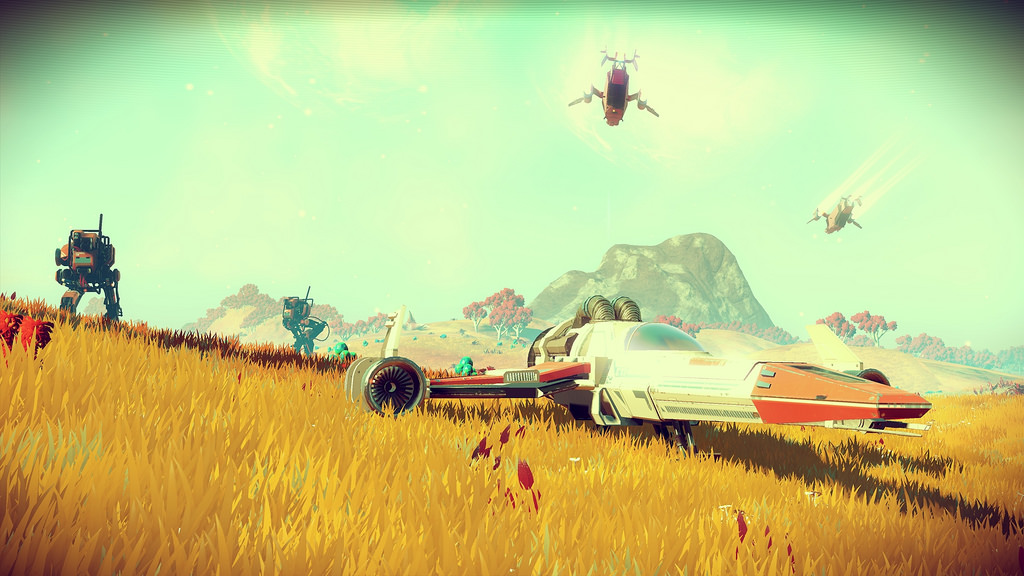
No Man’s Sky is a peaceful, colourful slice of sci-fi. When people ask me what it’s like, I say it’s very Minecrafty. You travel to galaxies to collect resources that allow you to travel to more galaxies and collect more resources. And you do this again and again until you’ve explored the universe. The act of doing this is so serene and calming, it’s a lovely refresher from the usual hyperkinetic games that come out this time of year. Also, there’s a lovely story doing the rounds of people naming the planets they find after dead relatives as a way to remember them. Pull-quote: “It’s one of 18 quintillion planets now and no one else may ever find it but I know it’s there and it has her name on it. That’s good enough for me.”
Hikea (video)
Web series where people take drugs assemble Ikea furniture. In the first episode, Giancarlo and Nicole take acid and build a chest of drawers and it’s actually super sweet.
A Burglar’s Guide to the City (book)
Geoff Manaugh (BLDGBLOG) is one of my favourite writers. In his book A Burglar’s Guide to the City, he talks about how burglars have used architecture to plan their robberies. If, like me, your favourite parts of heist films like Ocean’s Eleven are the bits where they construct elaborate recreations of the places they’re about to rob, then this book is right up your street.
Phone Sex Operators (article)
A series of portraits of the people on the other end of phone sex lines. Their stories are fascinating
# Aug 15, 2016“My first night was on a Saturday at midnight. It was a gentleman who I believe called himself Bob. He told me about his first experience with a glory hole. He explained that he had no one he felt comfortable telling this to, and I felt a strange intimacy between us, though it was rooted in a fantasy. I think it’s easier to release repressed desires to a non-judgmental, fictional person, because there are no consequences in the outside world.”
What's Making Me Happy - Week of August 1st
In an effort to push out the jive and bring in the love, I’m going to more of an effort to talk about the things that are bringing me joy.
Stranger Things

It never quite shakes off its influences (basically all of Spielberg’s early 80s films - Jaws, E.T., Close Encounters and Poltergeist), but as a piece of summer fluff, Stranger Things was surprisingly entertaining. It’s less cliffhanger-y than the other Netflix original shows, but it’s managed to achieve a pretty compelling vibe that draws you back for more. I’m interested to see what they do for season 2 now that they’ve basically tapped the 80s Spielberg well dry.
Sleeping Giants by Sylvain Neuvel
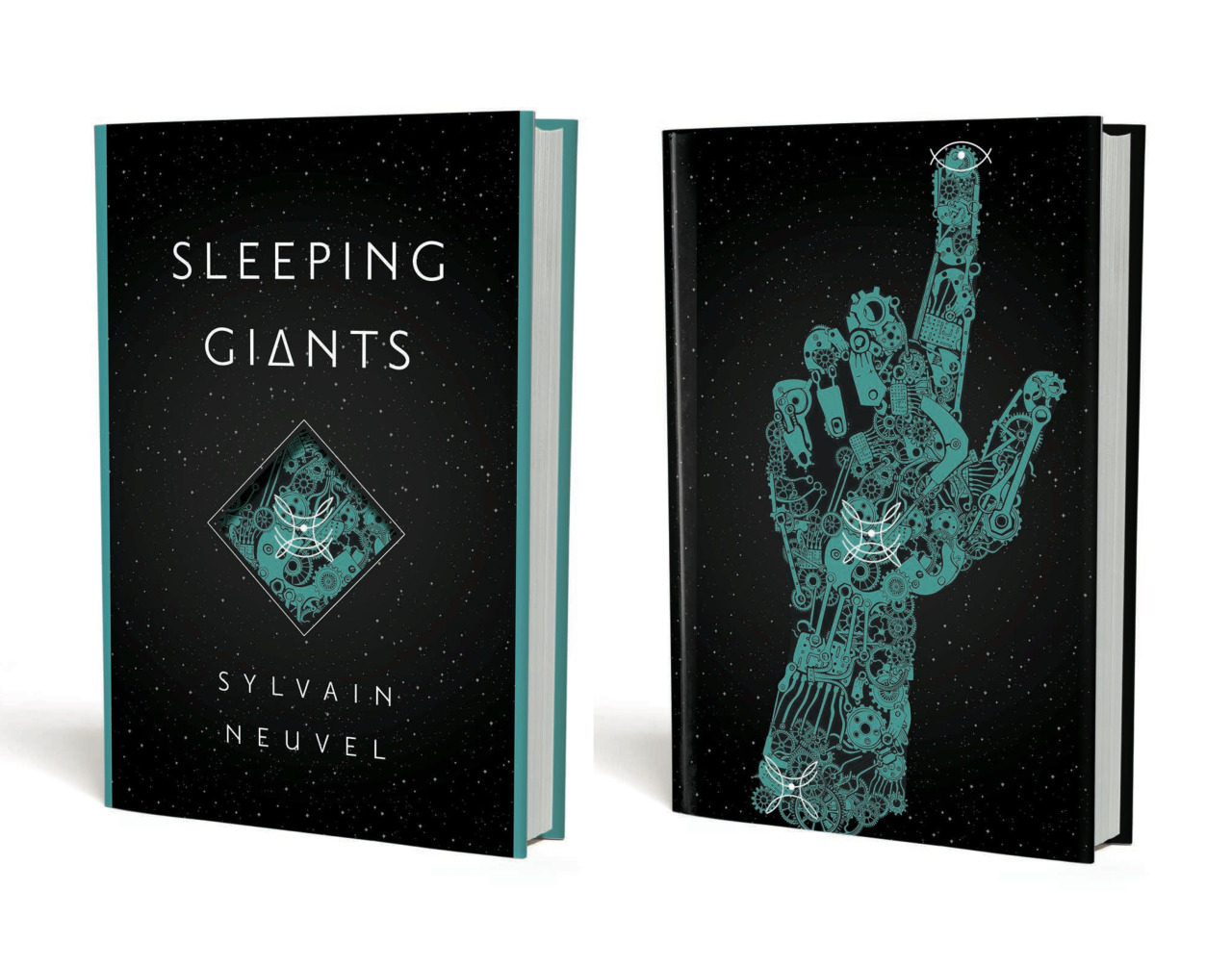
Sleeping Giants is a big dopey sci-fi thriller about the discovery of huge pieces of a statue from an ancient civilisation. And the whole thing is told in an epistolary manner, where each chapter is the transcript of an interview. So the information is drip-fed to the reader, increasing the tension. It’s not going to win any literary awards, but it’s so fast-paced and cinematic, it’s a great summer read.
Brie Larson as Captain Marvel
Call me Captain Marvel. pic.twitter.com/IgqRIb9ijM
— Brie Larson (@brielarson) July 24, 2016
A lot of great news came out of Comic Con. We got a rad Doctor Strange trailer, a pretty decent Wonder Woman trailer. But my absolute favourite news so far has been the announcement that Brie Larson will be playing Carol Danvers in the Captain Marvel film. This is some perfect casting.
Films You’d Love Your Kids to See
The Lighthouse Cinema here in Dublin are running a “Films you’d love your kids to see” season. Now, I question the logic of programming for kids and scheduling shows way too late for kids to actually attend. Still, I’m not going to turn up an opportunity to see The Goonies in the cinema.
Preacher
If, four months ago, you had asked me about my expectations for AMC’s adaptation of Preacher, I would have probably given you the vocal equivalent of the poop emoji. But the finale this week capped what turned out to be an unexpectedly great season of an unexpectedly great show. It’s not a straight one-for-one adaptation of the comic, but they absolutely nailed the tone of the books. Definitely worth checking out.
# Aug 1, 2016Hello Hugo
Last week, I began the process of moving this site from Jekyll to Hugo. Jekyll is great. Really great, actually. It was my first real experiment with static sites and it was really fun and taught me a lot. But I’ve been starting to feel its limits. I pumped in everything from the past iterations of my blog, through Wordpress and Tumblr, leaving me with over 1,400 posts. So building the site with Jekyll each time I wanted to update it was slowwwww. Jekyll’s other big draw – its GitHub integration is amazing – is great if you’re hosting your site there. But I’m not. I’m self-hosting. So I started looking at Hugo.
I also had a look at Middleman, which has some impressive names using it, but was just a deeply unpleasant experience as an end-user1.
So for funtimes, I wanted to see how long it would take a fresh, vanilla install of the three most popular static site generators – Jekyll, Middleman and Hugo – to render the 1,400+ individual markdown files that make up this blog.
Jekyll
35.35 real 31.04 user 2.50 sys
middleman
22.47 real 30.61 user 3.97 sys
hugo
8.12 real 8.96 user 1.45 sys
It’s hard to argue with this kind of performance improvement, but what sealed the deal was the fact they include a built-in hugo import jekyll command that can get you started migrating your site across. I had my entire site migrated across in less than an hour.
-
Middleman feels as if it’s been written for robots and not humans. To build your site in Jekyll, you type
jekyll build, which is easy to remember. To build it in Hugo, you just typehugo, which is almost impossible to forget. To build your site in MM, you typebundle exec middleman build, which yes, is easy enough to remember after you’ve done it a couple of times but my God, it’s so clunky and basically tells you everything you need to know about what it’s like to use Middleman. ↩︎